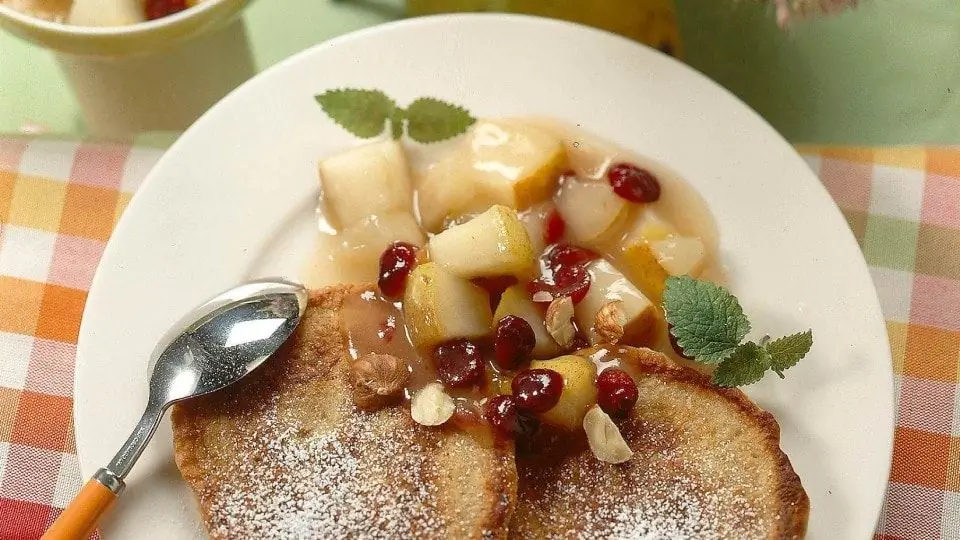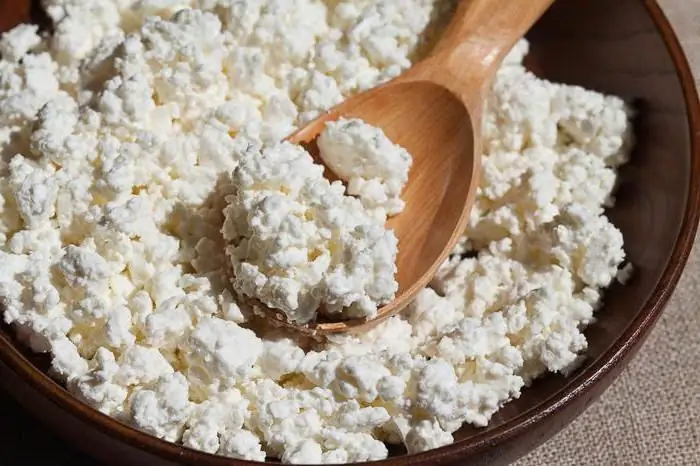2025 Author: Isabella Gilson | [email protected]. Last modified: 2025-01-23 12:50:41
It is believed that the most unusual and strange dishes are prepared only in exotic countries. But it's not. For example, in Italy blue cheese is considered a delicacy. However, compared to other dairy products, it will seem like just flowers. A more disgusting product is cheese with worms. No, he's not corrupted. It is specially prepared and eaten with great pleasure.
Usually people, without hesitation, throw rotten food into the bin, and even more so with live "stuffing". And this rotten cheese is consumed voluntarily, and even money is paid for it. However, the Ministry of He alth warns against eating such a specific delicacy. But first things first.

Deep into history
The delicacy itself with larvae is called casu marzu. The birthplace of cheese is the island of Sardinia, which is part of Italy. Apparently, in this country there is a special love for sour-milk delicacies. Who originally came up with this unusual dish, history is silent. One can only assume that one dayone farmer accidentally left a head of cheese infected with fly larvae to ripen. Then he was sorry to throw away an expensive product, he tried it and advertised it. Be that as it may, worm cheese has become a traditional dish of Sardinia, which is not averse to eating locals and even tourists.
For the production of this delicacy, farmers did a lot of work. It all started with the milking of sheep and ended with the transportation of the finished product. Often the exposure depended on the time the shepherd was on the field, because they made a delicacy outside their home. It is noteworthy that cheese with cheese fly larvae was made exclusively for their family. It was rarely taken for sale, and then, if something remains. Each farmer called his product "my cheese" and could recognize it among other heads not only by taste, but also by appearance. This was due to the fact that each family had a special recipe for cooking.

Cooking technology
Today, wormy food is made on the basis of Sardinian pecorino cheese, which is made from sheep's milk. The semi-finished product is cut and exposed to fresh air, where flies instantly flock to it to lay several thousand eggs. This is what farmers want. When the future cheese with worms is sufficiently infected, it is put on a shelf in storage.
After hatching, the larvae feed on an unfinished delicacy and produce waste products that accelerate fermentation - the decomposition of fats. Due to the accelerated disintegration in texture, the cheese becomes very soft, and fromliquid begins to flow out of it, which the locals conventionally call tears. Readiness is determined by eye - according to the degree of activity of the worms and their number. There can be several thousand of them in one head!
In terms of time, the entire process takes an average of three months. The finished product is really rotten, with a pronounced smell and a greenish-brown tint. It turns out that casu marzu is a cheese with live larvae that do not stop crawling while eating. This is why the strange Sardinian delicacy is popular. It looks a bit like a cheese made in Piedmont. Only the head, after laying eggs, is soaked in a mixture of white wine, grape juice and honey. This is to prevent the larvae from hatching.

A little about cheese flies
These flies are very tiny, on average their narrow body reaches four millimeters. Being agile, they usually live near fisheries, smokehouses, food warehouses and cheese factories. During the mating season, these flies lay 40 to 120 eggs. And they do it for fresh, smoked or s alty food: ham, lard, cheese, caviar, fish and other products that will attract them. But people do not hide kasa marzu from them at all.
Laid eggs thrive in the heat, and hatched larvae are incredibly viable. So, they can easily exist in a strong s alt solution and up to thirty hours in kerosene. No wonder these tenacious insects are distributed all over the world.
The harmfulness of the cheese fly
Fishthe economy from this winged insect suffers significant damage, since its population is often simply huge. The cheese fly is the causative agent of all kinds of myiasis (parasitic diseases). When its larvae get on the skin of people working in food factories, they cause festering sores on the forearms, palms and other areas. This is due to the fact that they are embedded under the epithelium.

If the worms penetrate the digestive tract, it can result in the destruction of certain sections of the mucous membrane, pain in the pit of the stomach and typhoid-like diseases. As you can see, cheese with cheese fly larvae can result in he alth problems. Everywhere people exterminate these insects by various means, but not in Sardinia.
Consequences of eating cheese
People, eating a Sardinian delicacy, expose themselves to great danger. What can such experiments lead to?
- Allergic reactions.
- Toxic poisoning.
- Abdominal pain.
- Vomiting.
- Diarrhea with blood.
- Infection of the intestines, which ends in damage to internal organs.
It's hard to disagree here that such consequences are too high a price for a piece of delicacy. However, the locals themselves claim that when eating cheese, the larvae must be alive, then everything will be fine.
Have you changed your mind about eating? Then cover your eyes, not your nose
Sardinian cheese with worms is considered to be the most dangerous in the world. But poisoning isn't all they can dolarvae. The fact is that they move not only by crawling, but also by jumping. And they can jump up to 15 centimeters in height. That is, right in the face of an extreme eater. Often worms do this out of fear, and not out of a desire to harm on purpose. Be that as it may, to avoid damage to the eyeball, it is recommended to cover the eyelids or wear special goggles.

Taste of unusual cheese
It's really hard to describe what kasu marzu tastes like. Some note a very delicate, viscous, creamy texture, the second highlight spicy, bitter notes, for others the delicacy is too spicy and burning, like a fire in the mouth. Fans of unusual food claim that the wormy dish tastes like the most ordinary macaroni and cheese. Some Sardinians honestly say that this delicacy is not so delicious to taste and eat worms. But they don't argue about tastes, because everyone has their own eating habits.
You with or without larvae?
Many people in Sardinia eat cheese right with the larvae, but there are always squeamish people. Therefore, there are several ways to eat a wormy delicacy. Courageous eaters put on goggles, cover their eyes with their hands, or simply don't lean low on the table at all.
To get rid of the live filling, a piece is wrapped in a dense sheet, depriving the worms of oxygen. They begin to jump and break against the paper walls with a characteristic crack. When everything calms down, the larvae are considered dead, and then the meal begins. Howevercheese with dead worms should not be eaten as they become toxic.
It is impossible to simply remove a thousand larvae. Therefore, cheese makers act more cunningly. They place the head in a plastic bag and tie it tightly. From the lack of oxygen, the worms leave their home, it remains only to shake off the extra inhabitants.

Features of eating the dish
The crust of cheese is not eaten, it is customary to eat only its inner soft part. The delicacy is divided into small pieces or cut off the top. Cheese pulp with larvae is taken out with a spoon or fork. Some Sardinians prefer to do it with traditional local flatbreads. Cheese is spread on one piece of bread, and the other is covered so that the worms do not jump out into the eyes. Such an unusual dinner is always accompanied by a glass of strong red wine (cannonau), which the residents also prepare themselves.
Kasu marzu cheese: price and points of sale
The cost of the delicacy is quite high - two hundred dollars per kilogram. Worm cheese is usually sold in tightly closed containers in small pieces of two hundred grams. However, this does not greatly smooth the situation. After all, tasting a delicacy costs about two thousand rubles!
Find the cheese with the larvae still need to try. Previously, it was officially banned for sale, but since 2010, the dish has nevertheless received the title of cultural heritage. The delicacy is not sold in stores, it can be found on the market or ordered from local cheese makers.

If youIf you have unusual taste preferences and someday you will be in Sardinia, then take a piece of bread and go in search of casu marzu. Just remember the dangers of this delicacy and think carefully about the consequences.
Recommended:
Diet cottage cheese pancakes in the oven: recipe and cooking tips. The benefits of cottage cheese, features of choosing a product for cheesecakes

Syrniki are loved by both adults and children. This is a great snack, delicious and he althy breakfast, hearty dinner. But the preparation of such a seemingly simple dish still raises a lot of questions. For every second hostess, they spread, stick or do not turn over. What is the recipe for the perfect cheesecakes? And how to choose cottage cheese?
Which cheese is suitable for soup? How to make cream cheese soup

The recipes of these most delicate dishes occupy one of the leading positions among analogues. Recently, more and more often housewives ask the question on the forums: how to cook soup from processed cheese? According to experts, it is better to use processed cheeses to prepare a delicious cheese soup, since they are more plastic and dissolve well in hot broth, giving the dish an appetizing milky color
Fat-free cottage cheese: calories per 100 grams. Cottage cheese with sour cream: calories per 100 grams. Vareniki with cottage cheese: calories per 100 grams

Cottage cheese refers to fermented milk products, has a low calorie content and is obtained by oxidizing milk, followed by decanting whey. According to the calorie content, it is divided into fat-free cottage cheese (calorie content per 100 g - 70%, fat content up to 1.8%), fat cottage cheese (19 - 23%) and classic (4 - 18%). There are many recipes for dishes with the addition of this product
Chechil (cheese). Smoked cheese "pigtail". Caucasian diet cheese

Tight braids, woven from elastic cheese mass, rightfully lie on store shelves next to other cheeses. Chechil - pickled cheese, the brother of Suluguni, but has its own individual delicate taste
Marmalade worms at home: recipes

How to cook gummy worms at home? The most popular recipes and cooking tips. The history of the appearance of marmalade, composition, useful properties. Cooking worms from natural ingredients

